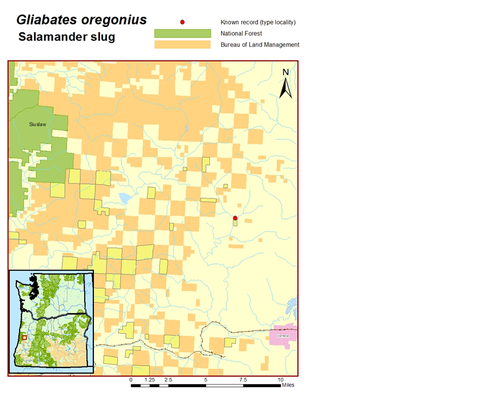Salamander Slug
Gliabatus oregoniusDescription 2
The taxonomic understanding of this species is based on a single holotype specimen in poor condition (Webb 1959, 1977, Leonard et al. 2011). The species was originally described by Webb (1959) as follows (Frest & Johannes 1999): a small (ca. 1 cm) elongate slug with a mantle about half the full body length. The body is gray, unmarked; the mantle is darker gray and the dorsal surface is posteriorly darker gray. Male anatomy is similar to Hesperarion except for the following: lacking definite verge; with a short epiphallus; and with a two-chambered penis with a medial lobate collar. Both basal spermathecal duct and vagina very greatly expanded; penis globular; penial retractor inserted on broad, bluntly rounded apex of penis; spermatheca more globular than in Hesperarion (Frest & Johannes 1999; Webb 1959). Webb (1977) provides further description of the holotype specimen, including illustrations of the radula, shell, partial mantle, and distal genitalia. Both the 1959 and 1977 papers, however, are incomplete, lacking descriptions of several characters and character states including the buccal and tentacular muscles, sole, pneumostome position, relative body proportions, mantle texture, presence/absence of a line of abcission on tail, and presence/absence of a caudal mucus pore (Leonard et al. 2011). As a result, the taxonomic placement of this species has been called into question (e.g., Frest & Johannes 1999, Roth 2004).
Habitat 2
This highly endemic species is known only from the type locality-the “east-bank of the Long Tom River, adjacent to Alderwood State Park” in the eastern foothills of the Coast Range, Lane County, Oregon (Webb 1959). Despite extensive mollusk surveys in the region, G. oregonius is known only from a single (type) specimen collected in 1959 (Leonard et al. 2011, Leonard 2012, pers. comm.). According to Leonard et al. (2011), while it seems improbable that Webb could have collected the last individual of a now extinct group, it cannot at this time be ascribed to any extant species—native or introduced.
Sources and Credits
- (c) Ian Throckmorton, all rights reserved, uploaded by Ian Throckmorton
- (c) Ian Throckmorton, some rights reserved (CC BY-SA)
More Info
Range Map

(c) koasmith, all rights reserved





